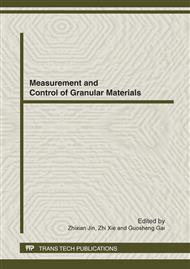p.1
p.6
p.11
p.16
p.21
p.25
p.29
p.33
Investigation of Flow Channel Geometry and Draw-Down in Funnel-Flow Bins and Stockpiles
Abstract:
Over the past 50 years, a strong foundation for the professional discipline of bulk solids handling has been provided, but so far, the theories for predicting funnel-flow are still quite empirical. In most cases, only two-dimensional stress field models are applied, which overestimate the stable pipe or rathole dimensions defining the core of the funnel and lead to draw-down and live capacity determinations, which are too conservative. More recently, Roberts [ introduced a new, more realistic, hoop stress theory based on the three-dimensional stress state occurring in a rathole. To verify the validity of the new theory, the current research upon which this paper is based, involves an experimental study of rathole formation in laboratory scale model funnel-flow bins and gravity reclaim stockpiles. A two-dimensional laser line scanner is used to depict rathole profiles, while load cells and pressure sensors are applied to determine instantaneous loads and pressure conditions during filling, storage and discharge. Iron ore fines are used as the test material, with the test program including flat-bottom bins with different diameters as well as varying filling levels and outlet diameters and stockpiles with variable heights and outlet diameters. The tests demonstrate the capability of laser scanning to describe rathole profiles. In addition, the suitability of the load cells and pressure sensors to describe the relevant funnel-flow parameters is shown.
Info:
Periodical:
Pages:
16-20
Citation:
Online since:
April 2012
Authors:
Keywords:
Price:
Сopyright:
© 2012 Trans Tech Publications Ltd. All Rights Reserved
Share:
Citation:


